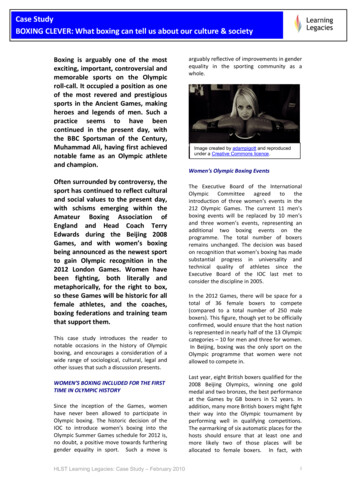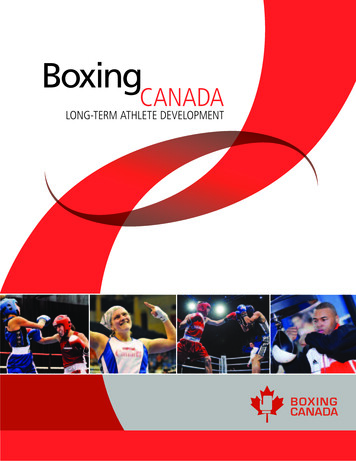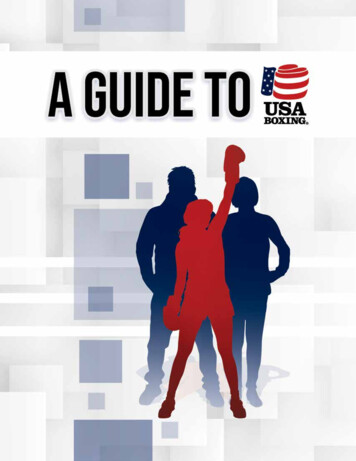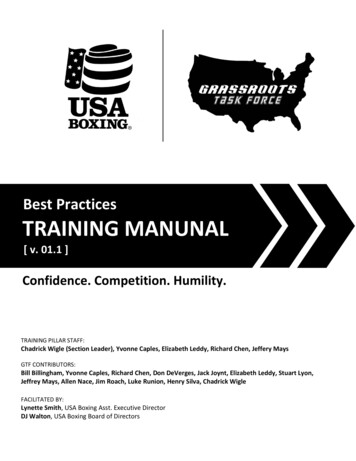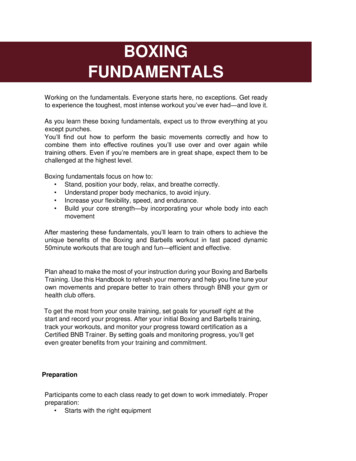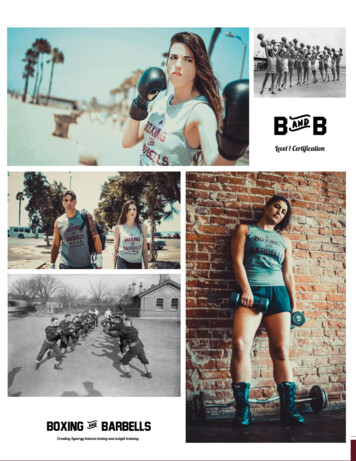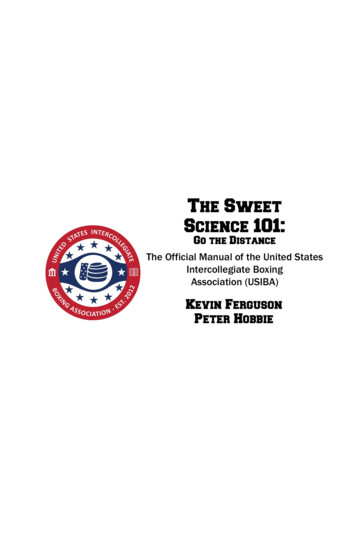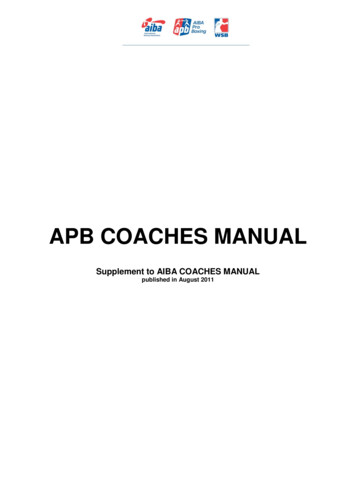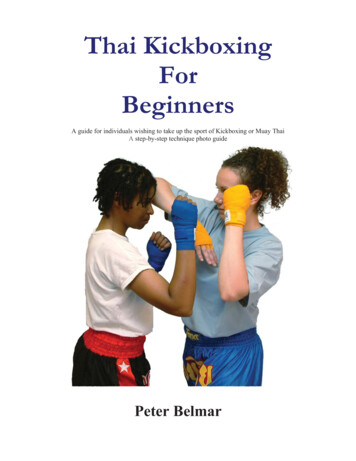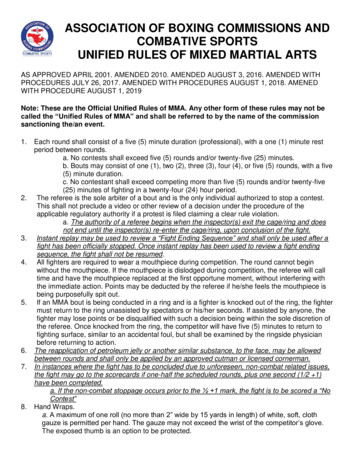
Transcription
ASSOCIATION OF BOXING COMMISSIONS ANDCOMBATIVE SPORTSUNIFIED RULES OF MIXED MARTIAL ARTSAS APPROVED APRIL 2001. AMENDED 2010. AMENDED AUGUST 3, 2016. AMENDED WITHPROCEDURES JULY 26, 2017. AMENDED WITH PROCEDURES AUGUST 1, 2018. AMENEDWITH PROCEDURE AUGUST 1, 2019Note: These are the Official Unified Rules of MMA. Any other form of these rules may not becalled the “Unified Rules of MMA” and shall be referred to by the name of the commissionsanctioning the/an event.1.2.3.4.5.6.7.8.Each round shall consist of a five (5) minute duration (professional), with a one (1) minute restperiod between rounds.a. No contests shall exceed five (5) rounds and/or twenty-five (25) minutes.b. Bouts may consist of one (1), two (2), three (3), four (4), or five (5) rounds, with a five(5) minute duration.c. No contestant shall exceed competing more than five (5) rounds and/or twenty-five(25) minutes of fighting in a twenty-four (24) hour period.The referee is the sole arbiter of a bout and is the only individual authorized to stop a contest.This shall not preclude a video or other review of a decision under the procedure of theapplicable regulatory authority if a protest is filed claiming a clear rule violation.a. The authority of a referee begins when the inspector(s) exit the cage/ring and doesnot end until the inspector(s) re-enter the cage/ring, upon conclusion of the fight.Instant replay may be used to review a “Fight Ending Sequence” and shall only be used after afight has been officially stopped. Once instant replay has been used to review a fight endingsequence, the fight shall not be resumed.All fighters are required to wear a mouthpiece during competition. The round cannot beginwithout the mouthpiece. If the mouthpiece is dislodged during competition, the referee will calltime and have the mouthpiece replaced at the first opportune moment, without interfering withthe immediate action. Points may be deducted by the referee if he/she feels the mouthpiece isbeing purposefully spit out.If an MMA bout is being conducted in a ring and is a fighter is knocked out of the ring, the fightermust return to the ring unassisted by spectators or his/her seconds. If assisted by anyone, thefighter may lose points or be disqualified with such a decision being within the sole discretion ofthe referee. Once knocked from the ring, the competitor will have five (5) minutes to return tofighting surface, similar to an accidental foul, but shall be examined by the ringside physicianbefore returning to action.The reapplication of petroleum jelly or another similar substance, to the face, may be allowedbetween rounds and shall only be applied by an approved cutman or licensed cornerman.In instances where the fight has to be concluded due to unforeseen, non-combat related issues,the fight may go to the scorecards if one-half the scheduled rounds, plus one second (1/2 1)have been completed.a. If the non-combat stoppage occurs prior to the ½ 1 mark, the fight is to be scored a “NoContest”Hand Wraps.a. A maximum of one roll (no more than 2” wide by 15 yards in length) of white, soft, clothgauze is permitted per hand. The gauze may not exceed the wrist of the competitor’s glove.The exposed thumb is an option to be protected.
b. A maximum of one roll (no more than 1.25” wide by 10’ in length) of white athletic tape ispermitted per hand. The tape may not exceed the wrist of the competitor’s gloves. Tape maybe placed through the fingers but may not cover the knuckles. The exposed thumb is an optionto be protected.c. A single layer of elastic or flex-type tape is allowed to be applied over the completed wrap.d. Approved tape/gauze of all brands may be allowed.9. Joint/Body Coverings.a. Other than the competitor’s hands, there will be no taping, covering, or protective gear, ofany kind, on the upper body. This includes, but is not limited to: joint sleeves, padding, or anyform of brace/body tape.b. A competitor may use a soft neoprene type sleeve to cover only the knee and/or anklejoints. Approved sleeves may not have: padding, Velcro, plastic, metal, ties, or any othermaterial considered to be unsafe or that may create an unfair advantage. Tape, gauze, or anymaterials other than the approved sleeves are not permitted.10. Cage/Ring Attire.a. All mixed martial artists will be required to wear such protective gear as deemed necessaryby the Commission.b. Male contestants shall not wear any form of clothing on their upper body.c. Male and female mixed martial artists shall wear the appropriate trunks, mouthpiece, andgloves. Male mixed martial artists shall also wear the appropriate groin protection.d. Female mixed martial artists shall wear a short sleeved (above the elbow) or sleevelessform fitting rash guard and/or sports bra(s). No loose-fitting tops and/or breast protectors shallbe allowed. Female competitors will follow the same requirements for bottom covering as themale competitors, minus the requirement for groin protection.e. The hem of the trunks may not extend below the knee.f. Fighting shorts/trunks shall not have exposed Velcro, pockets, or zippers.g. Mixed martial artists in the same match, contest, or exhibition may wear different colortrunks or be designated by glove taping and/or glove coloring to the corner they are assigned.h. Mixed martial artists shall not wear shoes in the cage or ring.i. When deemed necessary by the referee all mixed martial artists shall have their hair securedin a manner that does not interfere with the vision and safety of either contestant.i. No object can be worn to secure the contestant’s hair which may cause injury to eithercontestant.j. The wearing of jewelry will be strictly prohibited during all contests.k. Wearing body cosmetics shall be prohibited during all contests. Wearing facial cosmeticsshall be at the discretion of the commission and/or referee.Fouls1. Butting with the head;a. The head may not be used as a striking instrument in any fashion. Any use of the head as astriking instrument whether head to head, head to body or otherwise is illegal.2. Eye gouging of any kind;a. Eye gouging by means of fingers, chin, or elbow is illegal. Legal strikes or punches thatcontact the fighter's eye socket are not eye gouging and shall be considered legal attacks.3. Biting or spitting at an opponent;a. Biting in any form is illegal. A fighter must recognize that a referee may not be able tophysically observe some actions and must make the referee aware if they are being bit duringan exhibition of unarmed combat.4. Fish Hooking;a. Any attempt by a fighter to use their fingers in a manner that attacks their opponent's mouth,nose or ears, stretching the skin to that area will be considered “Fish hooking”. Fish hookinggenerally is the placing of fingers into the mouth or your opponent and pulling your hands inopposing directions while holding onto the skin of your opponent.
5.6.7.8.9.10.11.12.13.14.Hair pulling;a. Pulling of the hair in any fashion is an illegal action. A fighter may not grab a hold of hisopponent's hair to control their opponent in any way. If a fighter has long hair, they may notuse their hair as a tool for holding or choking in any fashion.Spiking the opponent to the canvas onto the head or neck (pile-driving);a. Any throw with an arc to its motion is to be considered a legal throw. It does not matter if theopponents head hits the canvas. A pile driver is considered to be any throw where you controlyour opponent's body placing their feet up in the air with their head straight down and thenforcibly drives the opponents head into the canvas or flooring material. It should be noted whena fighter is placed into a submission hold by their opponent, if that fighter is capable ofelevating their opponent, they may bring that opponent down in any fashion they desirebecause they are not in control of their opponent’s body. The fighter who is attempting thesubmission can either adjust their position or let go of their hold before being slammed to thecanvas.Strikes to the spine or the back of the head;a. The back of the head starts at the Crown of the head with a one (1) inch variance to eitherside, running down the back of the head to the occipital junction.b. This area stretches out at the occipital junction (nape of the neck) to cover the entire widthof the neck. It then travels down the spine with a one (1) inch variance from the spine’scenterline, including the tailbone.Throat strikes of any kind and/or grabbing the trachea;a. No directed throat strikes are allowed. A directed attack would include a fighter pulling hisopponents head in a way to open the neck area for a striking attack. A fighter may not gougetheir fingers or thumb into their opponent's neck or trachea in an attempt to submit theiropponent. If during stand-up action of a fight a strike is thrown and the strike lands in the throatarea of the fighter, this shall be viewed as a clean and legal blow.Fingers outstretched toward an opponent’s face/eyes;a. In the standing position, a fighter that moves their arm(s) toward their opponent with an openhand, fingers pointing at the opponent’s face/eyes, will be a foul. Referees are to prevent thisdangerous behavior by communicating clearly to fighters. Fighters are directed to close their fistsor point their fingers straight up in the air when reaching toward their opponent.Downward pointing elbow strike (12 to 6);a. The use of a linear “straight up straight down” elbow strike is prohibited. Any variation of thisstraight up and down linear elbow strike makes the strike legal. Any arc, or any angle changefrom straight up to straight down makes the strike legal. Any variation of position does not alterthe legality of the strike.Groin attacks of any kind;a. Any attack to the groin area including, striking, grabbing, pinching or twisting is illegal. Itshould be clear that groin attacks are the same for men and women.Kneeing and/or Kicking the head of a grounded opponent;a. A grounded fighter is defined as: Any part of the body, other sole of the feet touching thefighting area floor. To be grounded, the palm of one hand (a flat palm) must be down, and/orany other body part must be touching the fighting area floor. A single knee, arm, (not fingers)makes the fighter grounded without having to have any other body part in touch with thefighting area floor. At this time, kicks or knees to the head will not be allowed.Stomping of a grounded fighter;a. Stomping is considered any type of striking action with the feet where the fighter lifts theirleg up bending their leg at the knee and initiating a striking action with the bottom of their footor heel.b. Axe kicks are not stomping. Standing foot stops are NOT a foul. As such, this foul does notinclude stomping the feet of a standing fighter.Holding opponent's gloves or shorts;
15.16.17.18.19.20.21.22.23.24.a. A fighter may not control their opponent's movement by holding onto their opponent's shortsor gloves. A fighter may hold onto or grab their opponent's hand as long as they are notcontrolling the hand only by using the material of the glove, but by actually gripping the hand ofthe opponent. It is legal to hold onto your own gloves or shorts.Holding or grabbing the fence or ropes with fingers or toes;a. A fighter may put their hands on the fence and push off of it at any time. A fighter mayplace their feet onto the cage and have their toes go through the fencing material at anytime. When a fighter's fingers or toes go through the cage and grab hold of the fenceand start to control either their body position or their opponent's body position it nowbecomes an illegal action. A fighter may not grab the ropes or wrap their arms over orunder the ring ropes at any time. The fighter may not purposely step through the ropes.If a fighter is caught holding the fence, cage or ring rope material the referee may issuea one-point deduction from the offending fighters scorecard if the foul caused asubstantial effect in the fight. If a point deduction for holding the fence occurs, andbecause of the infraction, the fouling fighter ends up in a superior position due to thefoul, the fighters should be re-started by the referee, standing in a neutral position.Small joint manipulation;a. Fingers and Toes are small joints. Wrists, Ankles, Knees, Shoulders and Elbows areall large joints. Grabbing the majority of fingers/toes at once is allowed.Throwing an opponent out of the ring or caged area;a. A fighter shall not throw their opponent out of the ring or cage.Intentionally placing a finger into any orifice, or into any cut or laceration of your Opponent;a. A fighter may not place their fingers into an open laceration in an attempt to enlargethe cut. A fighter may not place their fingers into an opponent's, nose, ears, mouth, orany body cavity.Clawing, pinching, twisting the flesh;a. Any attack that targets the fighter's skin by clawing at the skin or attempting to pull ortwist the skin to apply pain is illegal.Timidity (avoiding contact, or consistently dropping the mouthpiece, or faking an injury;a. Timidity is defined as any fighter who purposely avoids contact with his opponent orruns away from the action of the fight. Timidity can also be called by the referee for anyattempt by a fighter to receive time by falsely claiming a foul, injury, or purposelydropping or spitting out their mouthpiece or other action designed to stall or delay theaction of the fightUse of abusive language in the fighting area;a. The use of abusive language is not allowed during MMA competition. It is the soleresponsibility of the referee to determine when language crosses over the line toabusive. It should be clear that fighters can talk during a match. The mere use ofauditory language is not a violation of this rule. Examples of abusive language would be(Racially motivated or Derogatory language).Flagrant disregard of the referee's instructions;a. A fighter MUST follow the instructions of the referee at all times. Any deviation ornon-compliance may result in the fighter's disqualification.Unsportsmanlike conduct that causes an injury to opponent;a. Every athlete competing in the sport of MMA is expected to represent the sport in apositive light emphasizing sportsmanship and humility. Any athlete that disrespects therules of the sport or attempts to inflict unnecessary harm on a competitor who has beeneither taken out of the competition by the referee or has tapped out of the competitionshall be viewed as being unsportsmanlike.Attacking an opponent after the bell has sounded the end of the period of unarmed combat;
a. The end of a round is signified by the sound of the bell and the call of time by thereferee. Once the referee has made the call of time, any offensive actions initiated bythe fighter shall be considered after the bell and illegal.25.Attacking an opponent on or during the break;a. A fighter shall not engage their opponent in any fashion during a time-out or break ofaction in competition.26.Attacking an opponent who is under the care of the referee;a. Once the referee has called for a stop of the action to protect a fighter who has beenincapacitated or is unable to continue to compete in the fight, fighters shall cease alloffensive actions against their opponent.27.Interference from a mixed martial artist’s corner or seconds;a. Interference is defined as any action or activity aimed at disrupting the fight orcausing an unfair advantage to be given to a corner’s combatant. Corners are notallowed to distract the referee or influence the actions of the referee in any fashion.A. Intentional Fouls1. If an intentional foul causes an injury, and the injury is severe enough to terminate the boutimmediately, the fighter causing the injury shall lose by disqualification.2. If an intentional foul causes an injury and the bout is allowed to continue, the referee shallnotify the authorities and deduct two (2) points from the fighter who caused the foul. Pointdeductions for intentional fouls will be mandatory.3. If an intentional foul causes a laceration and/or swelling and the bout is allowed to continue,and the injury results in the fight being stopped in any round after ½ of the scheduled rounds,plus one (1) second of the fight has been completed, by eitheranother legal or illegal strike, the injured fighter will win by TECHNICAL DECISION if they areahead on the score cards; and the bout will result in a TECHNICAL DRAW if the injured fighteris behind or even on the score cards.4. If the fighter injures himself/herself while attempting to intentionally foul their opponent, thereferee will not act in their favor, and this injury shall be the same as one produced by a fairblow.5. If the referee feels that a fighter has conducted themselves in an unsportsmanlike manner,they may stop the action of the fight to deduct points or stop the bout to disqualify the fighter.B. Accidental Fouls1.If an accidental foul causes an injury severe enough for the referee to stop the bout, the boutwill result in either a NO CONTEST or DISQUALIFICATION if stopped before ½ of thescheduled rounds, plus one (1) second of the fight has been completed.2. If an accidental foul causes an injury severe enough for the referee to stop the bout after ½of the scheduled rounds, plus one (1) second of the fight has been completed, the bout willresult in a TECHNICAL DECISION awarded to the fighter who is ahead on the score cards atthe time the bout is stopped.i. Partial or incomplete rounds will be scored. If no action has occurred, the roundshould be scored as an even round. This is at the discretion of the judges.3. If a fighter, during the course of a round, visibly loses control of bodily function (vomit, urine,feces), the fight shall be stopped by the referee and the fighter shall lose the contest by aTechnical Knockout (TKO) due to Medical Stoppage.i. In the event a loss of bodily function occurs in the rest period between rounds, theringside physician shall be called in to evaluate if the combatant can continue. If thecombatant is not cleared by the ringside physician to continue, that combatant shall loseby a Technical Knockout (TKO) due to Medical Stoppage.
ii. If fecal matter becomes apparent at any time, the contest shall be halted by the referee, andthe offending combatant shall lose by a Technical Knockout (TKO) due to Medical StoppageC. Foul Procedures: If a foul is committed, the referee shall:1. Call Time;2. Check the fouled mixed martial artist’s condition and safety; and3. Assess the foul for potential point(s) deductions and/or time considerations.4. During all time out procedures, there shall be no coaching of a contestant permitted.D. Time Consideration:1. If a foul to the groin occurs and the competitor is able to continue, the fouled contestant mayhave up to five (5) minutes to recover.2. Fighters injured severely enough by a foul to require medical consultation may be given upto five (5) minutes, at the referee’s discretion, for evaluation by the ringside physician before adecision to continue is rendered.3. At no time may a referee call a timeout to evaluate the impact of a legal strike, other thanwhen a laceration is present.A. Judging Criteriaa. All bouts will be evaluated and scored by a minimum of three (3) judges.b. The 10 Point Must System will be the standard of scoring about.i. Under the 10-Point Must Scoring System, 10 points must be awarded to the winner ofthe round and nine points or less must be awarded to the loser, except for a rare evenround, which is scored (10-10).c. Judges shall evaluate Mixed Martial Arts techniques, such as effectivestriking/grappling(Plan A), effective aggressiveness(Plan B),and control of the fightingarea(Plan C).Plans B and C are not taken into consideration unless Plan A is weighed asbeing even.d. Evaluations shall be made in the specific order in which the techniques appear in(c)above ,giving the most weight in scoring to effective striking/grappling, and effectiveaggressiveness, and control of the fighting area.e. Effective striking is judged by determining the impact/effect of legal strikes landed by acontestant solely based on the results of such legal strikes. Effective grappling is assessed bythe successful executions and impactful/effective result(s)coming from: takedown(s),submission attempt(s), achieving an advantageous position(s) and reversal(s).f. Effective aggressiveness means aggressively making attempts to finish the fight.g. Fighting area control is assessed by determining who is dictating the pace, place andposition of the bout.1.Thefollowing objective scoring criteria shall be utilized by the judges when scoring a round:(i) Around is to be scored as a 10-10 Round when both contestants have competed forwhatever duration of time in the round and there is no difference or advantage between eitherfighter;(ii)Around is to be scored as a 10-9 Round when a contestant wins by a close margin; wherethe winning fighter lands the better strikes or utilizes effective grappling during the round;(iii)A round is to be scored as a 10-8 Round when a contestant wins the round by a largemargin by impact, dominance, and duration of striking or grappling in a round.(iv)A round is to be scored as a 10-7 Round when a contestant is completely dominated byimpact, dominance, and duration of striking or grappling in a round.2. Impact: A judge shall assess if a fighter impacts their opponent significantly in the round, eventhough they may not have dominated the action. Impact includes visible evidence such as swelling
and lacerations. Impact shall also be assessed when a fighter’s actions, using striking and/orgrappling, lead to a diminishing of their opponent’s energy, confidence, abilities and spirit. All of thesecome as a direct result of impact. When a fighter is impacted by strikes, by lack of control and/orability, this can create defining moments in the round and shall be assessed with great value.3. Dominance: As MMA is an offensive based sport, dominance of a round can be seen in strikingwhen the losing fighter is forced to continually defend, with no counters or reaction taken whenopenings present themselves. Dominance in the grappling phase can be seen by fighter stakingdominant positions in the fight and utilizing those positions to attempt fight ending submissions orattacks. Merely holding a dominant position(s) shall not be a primary factor in assessing dominance.What the fighter does with those positions is what must be assessed.4. Duration: Duration is defined by the time spent by one fighter effectively attacking, controlling, andimpacting their opponent; while the opponent offers little to no offensive output. A judge shall assessduration by recognizing the relative time in a round when one fighter takes and maintains full controlof the effective offense. This can be assessed both standing and grounded.5. Scoring of Incomplete Rounds: There should be scoring of incomplete rounds. If the refereepenalizes either contestant, then the appropriate points shall be deducted when the scorekeepercalculates the final score for the partial roundB. Types of Decisionsa. Submission by:i. Tap Out: When a contestant physically uses of their body to indicate that he or she no longerwishes to continue; orii. Verbal Tap Out: When a contestant verbally announces or voluntarily/involuntarily screamsin pain or distress to the referee that they do not wish to continue;iii. Technical Submission: When a legal submission act results in unconsciousness orbroken/dislocated bone(s)/joint(s).b. Technical Knockout (TKO) by:i. Referee Stoppage: the referee stops the contest because the combatant IS NOTINTELLIGENTLY DEFENDING HIMSELF/HERSELF;1. Strikes2. Laceration3. Corner Stoppage4. Did Not Answer the Bellii. TKO due to Medical Stoppage;1. Laceration2. Doctor Stoppage3. Loss of control of bodily function.c. Knockout (KO) by:i. Referee Stoppage: the referee stops the contest because the combatant CANNOTINTELLIGENTLY DEFEND HIMSELF/HERSELF.1. Due to Strikes
d. Disqualification:i. When an injury sustained during competition as a result of an intentional foul is severeenough to terminate the contest, multiple fouls have been assessed, and/or there is flagrantdisregard for the rules and/or referee’s commands.e. No Contest:i. When a contestant is prematurely stopped due to accidental injury and a sufficient amount oftime has not been completed to render a decision via the score cards.f. Decisions:i. Unanimous Decision: When all three judges score the bout for the same contestant;ii. Split Decision: When two judges score the bout for one contestant and one judge scores forthe opponent; oriii. Majority Decision: When two judges score the bout for the same contestant and one judgescores a draw;iv. Technical Decision: When a bout is prematurely stopped due to injury from an accidentalfoul and a contestant is leading on the score cards;g. Draws:i. Unanimous Draw – When all three judges score the bout a draw;ii. Majority Draw – When two judges score the bout a draw; oriii. Split Draw – When all three judges score differently and the score total results in a draw;iv. Technical Draw - When an injury is sustained during competition as a result of an intentionalfoul and the bout is allowed to continue, then later the injury requires stoppage from either alegal or illegal strike to the affected area after ½ of the scheduled rounds, plus one (1) secondhas been completed, if the injured contestant is even or behind on the score cards at the timeof stoppage, the decision is a Technical Draw.
Weight ClassesWeight ClassWeightAtomweightup to and including 105 lbs.Straw Weightover 105 to 115 lbs.Flyweightover 115 to 125 lbs.Bantamweightover 125 to 135 lbs.Featherweightover 135 to 145 lbs.Lightweightover 145 to 155 lbs.Super Lightweightover 155 to 165 lbs.Welterweightover 165 to 170 lbs.Super Welterweightover 170 to 175 lbs.Middleweightover 175 to 185 lbs.Super Middleweightover 185 to 195 lbs.Light Heavyweightover 195 to 205 lbs.Cruiserweightover 205 to 225 lbs.Heavyweightover 225 to 265 lbs.Super Heavyweightover 265 lbs.a. Allowances within Division: there are no allowance restrictions if both combatants weigh-inwithin the same contracted division.b. Weight Miss Catch Weight: If a person misses the contracted weight and the two competitors arein different weight classes, the heavier opponent shall not exceed five (5) lbs. of the lower weighingfighter.c. Contracted Catch Weight(s): there is no weight spread allowance between contracted catchweight fighters, so long as both competitors are below the contracted weight. Commissions may denyCatch Weight fights if they see the weight differential as a large enough disparity to the safety ofeither of the fighters.*Items that are displayed as Italicized and Underlined are Procedural Recommendations from theABC MMA Rules and Regulations Committee, rather than Unified Rules of MMA.*Items that are underlined and in blue were voted on and approved at the July 2019 ABC Conference
Mixed martial artists in the same match, contest, or exhibition may wear different color trunks or be designated by glove taping and/or glove coloring to the corner they are assigned. h. Mixed martial artists shall not wear shoes in the cage or ring. i. When deemed necessary by the referee all mixed martial artists shall have their hair secured

